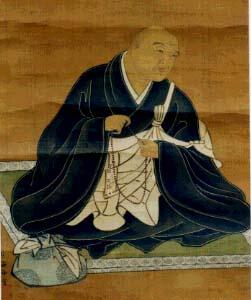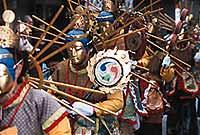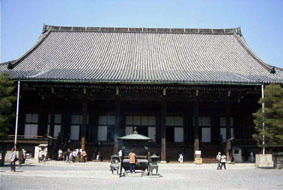[ . BACK to WORLDKIGO TOP . ]
:::::::::::::::::::::::::::::::::::::::::::::::::::::::::::::::::::::::::::::::::::::::::::::::::::::
- - - BACKUP
. 法然上人 Saint Honen (1133-1212) .
Saint Hoonen, Hoonen Shoonin, Honen
法然上人
Founder of Pure Land Buddhism
For kigo about his memorial day see below.
I live very close to the temple where Honen was born, Tanjoo-Ji in Okayama prefecture.
Posthumously known as Enko Daishi 円光大師
:::::::::::::::::::::::::::::::::::::::::::::::::::::::::::::::::::::::::::::::::::::::::::::::::::::
The Life of Honen Shonin

Honen Bo Genku (1133-1212), or simply Honen, is one of the most outstanding figures in the long history of Japanese Buddhism. Along with Dogen, Nichiren and Shinran, his disciple, he represents the core of the revolutionary Kamakura Buddhist movement which created the first popular and uniquely Japanese forms of Buddhism. Though not as noted in the West than these counterparts, Honen is perhaps the most pivotal of the four since he was the first to break with the established centers of Tendai (Ch. T'ien T'ai) and Shingon (tantric) patronized by the royal court and military authorities.
It was at age 43, with a deepening exposure to the Pure Land teachings of the great Chinese Master Shan-tao (Jp. Zendo), that Honen made this radical break to pursue his own spiritual vision. The rest of his life is an unfolding of his own particular and uniquely Japanese vision of Pure Land Buddhism. This second period of his life also marks the blooming of his teachings amongst the peasant classes of medieval Japan and his clashes with imperial and shogunal authority.
From his systematization of a unique Japanese Pure Land tradition, the nembutsu (念仏nenbutsu), or calling on the grace of Amida Buddha, has become the most popular form of Buddhist practice and devotion in Japan. Two of Japan's largest denominations, Jodo-shu (浄土宗 joodoshu) centered around Honen and Jodoshin-shu centered around his disciple Shinran, are further marks of his legacy.
I. A Personal Portrait
Major Biographies of Honen
II. Early Life and Training in Tendai-shu
Social and Religious Turmoil in Late Heian Japan
Syncretic Development of the Tendai School in Japan
Tendai-shu Esoteric and Exoteric Lineages
The Influence of Genshin's Ojoyoshu on Honen
III. Religious Conversion
Textual Evidence in the Biographies
IV. Persecution and Final Days
Kofuku-ji Petition (Kofuku-ji sojo)
A CHRONOLOGY OF HONEN SHONIN
1133 Born on April 7 in Mimasaka in present day Okayama Prefecture
1145 Leaves home to become a monk at the Tendai center of Mt. Hiei
1150 Moves to the Kurodani Retreat area of Mt. Hiei and studies under Eiku
1175 Has conversion experience reading Shan-tao's Commentary on the Meditation Sutra and leaves Mt. Hiei.
1186 "Ohara Debate" with group of Buddhist scholar-monks from Nara and Mt. Hiei marks seminal moment in legitimation and spread of teachings
1191 Gives series of lectures on the Three Pure Land Sutras (jodosanbukyo) to a large group of scholar monks at Todai-ji in Nara
1195 Genchi becomes the first of his major disciples
1198 Honen's magnum opus, the Senchaku Hongan Nembutsu Shu (Passages on the Selection of the Nembutsu in the Original Vow), is dictated and transcribed to his disciples Junsai, Kansai and Shoku.
1198-1206 Experiences sustained states of absorption and spontaneous visualization of the Pure Land which he chronicles in the Sanmai-hottokuki (Record of Attaining Samadhi)
1201 Shinran, the founder of Jodo Shinshu, becomes his disciple
1204 Writes the Shichikajo-kishomon (Seven Article Pledge) in response to the Genkyu Oppression by the monks of Mt. Hiei
1207 Sent into exile to Shikoku by Emperor Gotoba after two of his ladies in waiting are converted and become nuns under Honen's disciples Anraku and Juren who are subsequently beheaded.
1211 Finally is allowed to return to Kyoto four years after his pardon
1212 Writes Ichimai Kishomon (The One Sheet Document) and passes away on January 23 reciting the nembutsu
http://www.jsri.jp/English/Honen/life.html
http://www.jsri.jp/English/Main.html
:::::::::::::::::::::::::::::::::::::::::::::::::::::::::::::::::::::::::::::::::::::::::::::::::::::
Honen: The Life and Art of the Founder of the Pure Land Buddhist Sect'
Kyoto National Museum, till May 8, 2011
quote
The portrait of Honen Shoin (13th century) is known in Japanese as "Kagami no Miei" (mirror portrait 鑑御影) and shows the famous Buddhist priest seated on a mat, slightly slumped and holding his nenju (rosary). For the title of another famous 13th-century depiction of a well-known Buddhist priest, Shinran, the same kanji characters are given a slightly different reading. This time the mirror portrait is titled "Kagami no Goei."
Though the popularity of their faiths rose during the Kamakura Period (1185-1333), Honen and Shinran were not the originators of Pure Land Buddhism, which is believed to have arrived from India via China as early as the 7th century. In 1175, after decades of study, Honen read the "Meditation Sutra" by the Chinese Pure Land monk Shandao (613-681) and arrived at the understanding that the exclusive practice of nembutsu was needed to be reborn in the Western Pure Land paradise.
and
Shinran : The Founder of the Jodo-Shinshu Buddhism: His Life and Legacy
Kyoto Municipal Museum of Art, till May 29, 2011
source : Japan Times
:::::::::::::::::::::::::::::::::::::::::::::::::::::::::::::::::::::::::::::::::::::::::::::::::::::
More details about Saint Honen .
The Memorial Statue of the Mother of Saint Honen in Mimasaka.

© Gabi Greve
http://happyhaiku.blogspot.com/2005/04/cherry-blossom-lake.html
Tanjoo-ji 誕生時
The Ceremony of the 25 Bosatsu 二十五菩薩練供養
Third Sunday in April

http://www.town.kumenan.okayama.jp/tanjoji/tanjoji.html
This temple is also famous for its huge Gingko biloba tree (another kigo).
:::::::::::::::::::::::::::::::::::::::::::::::::::::::::::::::::::::::::::::::::::::::::::::::::::::
Memorial Ceremony for Honen, April 18 to April 25
This is a kigo for late spring, category Observance. There are some variations for this kigo.
Gyoki 御忌
Hoonen-ki (Honenki) 法然忌
Enkoo-Ki 円光忌
taking part in the ceremony, gyoki moode 御忌詣で
Temple with a memorial ceremony, gyoki no tera 御忌の寺
loosening the strings of the sutras, kyoo no himotoki 経の紐解き
..... (on the first day of the seven day ceremonies)
special kimono for the gyoki ceremony, gyoki kosode 御忌小袖
..... (worn by the chique ladies of Kyoto for this ceremony)
Ceremony for Hoonen, gyoki-e 御忌会
..... (sometimes on the 25 of January)
First Lunchbox, bentoo hajime 弁当初め > Lunchbox (kigo)
..... (visitors bring their own lunchbox and enjoy it in the temple grounds)
The Gyoki Ceremony at Temple Chion-In, Kyoto
Chio-in is just north of the Yasaka Shrine and Maruyama Park.It is the head temple of the Jodo ("Pure Land") sect of Buddhism. It is one of the most important spritual places in Japan. The Jodo sect is the most popular Buddhist sect in Japan.
The 74-tons temple bell is also the largest in Japan. It takes as many as 17 monks to operate it at the New Year ceremony in which the bell is struck 108 times representing the 108 desires in the mind to be gotten rid of before the new year begins
http://www.op97.org/cyberteen/2004/winter/chionin/
Picture Scroll of his Life at the Chion-In
http://www.chion-in.or.jp/c_00/index.html
http://www.chion-in.or.jp/home.html
. WKD : Haiku about Chion-in 知恩院 / 智恩院 .
:::::::::::::::::::::::::::::::::::::::::::::::::::::::::::::::::::::::::::::::::::::::::::::::::::::
The Gyoki Ceremony at Kita Kogane, with many pictures
http://www.h5.dion.ne.jp/~tadataka/matsuri/gyoki.html
Great photo of the pagoda by Frantisek Staud
http://phototravels.net/japan/pcd1663/pagoda-chion-47.html
Chion-In with many pictures of the compounds.

http://www5e.biglobe.ne.jp/~hidesan/chion-in.htm
:::::::::::::::::::::::::::::::::::::::::::::::::::::::::::::::::::::::::::::::::::::::::::::::::::
分かれても まだ会える 浄土あり
Joodo Paradise -
the place where we meet again
after we part
Gabi Greve, April 2007
:::::::::::::::::::::::::::::::::::::::::::::::::::::::::::::::::::::::::::::::::::::::::::::::::::::
. Tanjo-Ji in Autumn 2007
The Huge Gingko Tree
autumn deepens -
the beauty of prayer
in stone
. . SPRING FESTIVAL 2008
Tanjo-Ji Neirkuyo 誕生時 練り供養
. The Big Buddha of Tanjo-Ji 2009
. O-Shichi Kannon お七観音
. More of my PHOTOS from Temple Tanjo-Ji
Take the Slide Show !
:::::::::::::::::::::::::::::::::::::::::::::::::::::::::::::::::::::::::::::::::::::::::::::::::::::
[ . BACK to WORLDKIGO TOP . ]
[ . BACK to DARUMA MUSEUM TOP . ]
:::::::::::::::::::::::::::::::::::::::::::::::::::::::::::::::::::::::::::::::::::::::::::::::::::::
11/29/2009
Honen and Temple Tanjo-Ji
Posted by
Gabi Greve
at
11/29/2009
![]()
Labels: Japan
Subscribe to:
Post Comments (Atom)





3 comments:
In Hiroshima at Seiko village 南生口村
|At the temple 松蟲寺 Matsumushi-Dera, 法然上人 Saint Honen left his walking stick and it became a
sandalwood tree (byakudan 白檀).
.
There are other legends about a growing walking stick told by Yanagida Kunio.
.
Yosa Buson
なには女や京を寒がる御忌詣
naniwa me ya Kyoo o samugaru gyoki moode
Gals from Naniwa!
Attending the Hōnen Service that
makes Kyoto feel cold.
Tr. James Karkoski
.
Details are here
https://matsuobasho-wkd.blogspot.jp/2012/06/naniwa-osaka.html
.
Legend
Tokushima 徳島県 鳴門市 Naruto city 北灘 Kitanada / 撫養町 Muyacho
The local Oni heard to Buddhist lectures of Saint Honen, abdicated his bad ways, wrote a Buddhist name on his horns and threw his body down a cliff.
To appease his soul, the temple 鬼骨寺 Kikotsu-Ji "Temple of Demon Bones" was built.
The temple 法泉寺 Hosen-Ji venerates his myoogo 名号 Myogo, Buddhist name, the horns 鬼角.
The temple 西福寺 Saijuku-Ji venerates oni no ha 鬼の歯 his teeth.
. Kikotsuji 鬼骨寺 Kikotsu-Ji "Temple of Demon Bones" .
.
https://kappapedia.blogspot.jp/2017/09/oni-no-karada-body-features.html
.
Post a Comment